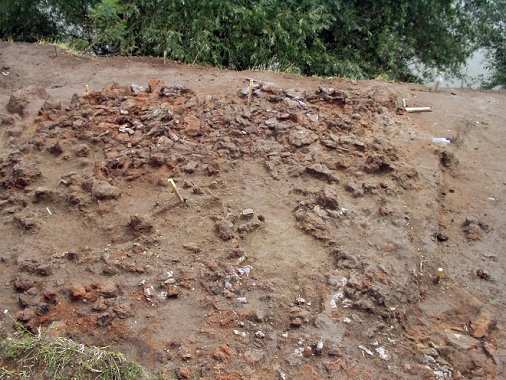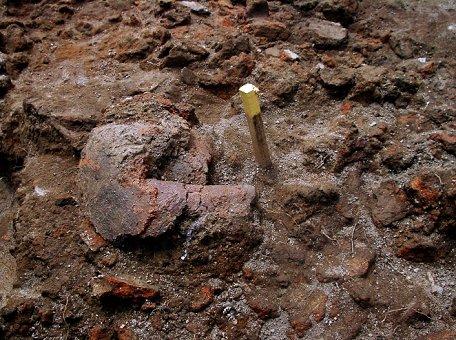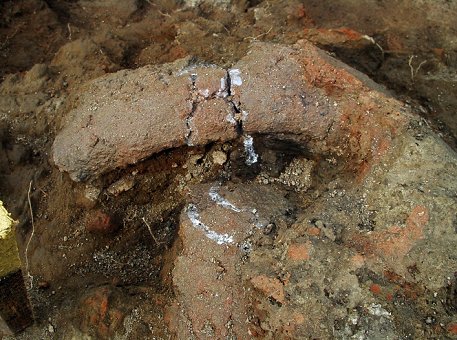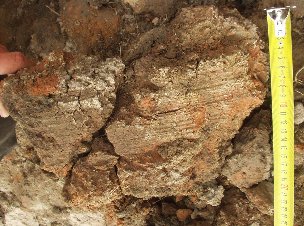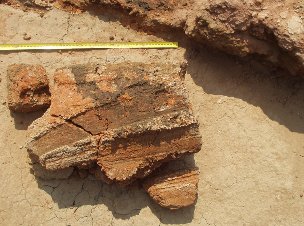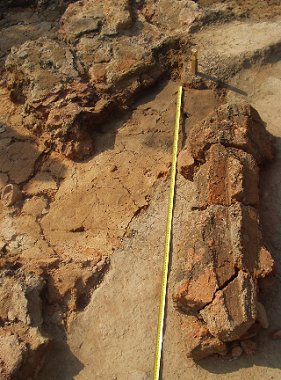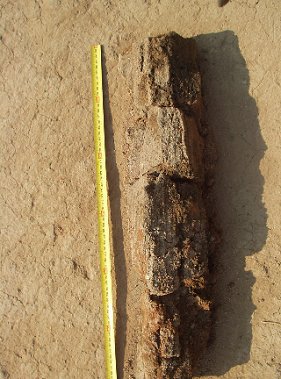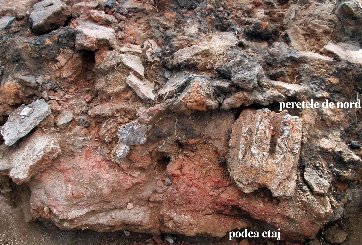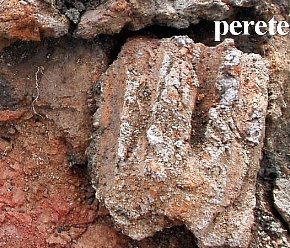

Room D (in the middle of 2005 excavation) is
almost entirely investigated. About 1.50 m of it has been previously
investigated. Because of huge quantity of adobes, we stopped our
examination at this level (we covered the area with plastic and
earth in order to preserve it for the future excavation).
The garret or the attic After removing the upper part of the ruins from level 5, we noticed other strong ruins in the same room, one to the north and another to the south (fig. 29). After this we discovered a floor over both rooms. The higher part was related with the wall ruins fallen down also in the interior.
At the level of the first ruins we discovered some plate fragments, flat on both sides. The firing was from both directions (black in the middle when the fragments are bigger; red, fired with a lot of oxygen, when are smaller). Between these fragments of architectonic elements not very well fired (fragments of door leafs or pedestals) were found. Sometimes pot fragments have been discovered between these or on top of these plates. These plates have fallen down on the ruins of the lateral walls. We consider that they belong to the garret structure. The ruins of the store (the walls and the floor) The ruins of the store consist in wall fragments fallen down over the pots or fired bones. 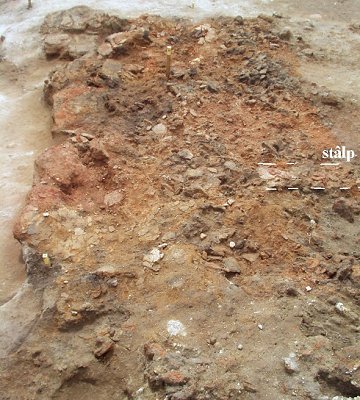 The
external part of the walls has only one or two clay plastering (internal
face of the walls has only the pillars and rod structure). On the
west wall, a pillar and its soldering fell down to the interior
and burned, indicating the direction of the pillar and of the wall
(see in fig. 29a, area marked „stâlp”). The
external part of the walls has only one or two clay plastering (internal
face of the walls has only the pillars and rod structure). On the
west wall, a pillar and its soldering fell down to the interior
and burned, indicating the direction of the pillar and of the wall
(see in fig. 29a, area marked „stâlp”). Sometimes the walls are made of weaved rods; more often the pillars are horizontally arranged, upright to the wall and only in few cases oblique (fig. 43a). This last position is hard to prove, because the fragments are so small in size (maybe they just fell down oblique). Under the ruins of the walls many fragments of big pots were found. The walls from the upper level are generally less fired, because their structure consisting in pillars and rods did not offer enough wood for a stronger combustion. Therefore the exterior clay plaster is fired weakly, or just baked, having a yellowish color (fig. 29). Most part of the upper level walls fell down in the interior; this suggests a previous demolishing of the floor and their attraction to the interior. These walls fell down with the pillars and rod structure in the interior (on their exterior we noticed 2-3 strata plastered with clay). Fig. 29b. Casa Cerbului, room D, ruins from the wall; view from the north We have investigated the way these pillar structures were burned and preserved. We seldom find adobes fragments plastered with clay on both sides. This suggests that when the wooden structure burned, some parts of it were detached; or some parts have been detached even before the burning. We can assume that these parts have only been baked (baking is just a weaker burning) having a dusty aspect. The window or the box from the store In the southern part of room D, to the east, between the ruins of the floor, an architectonic element was found. It seems to be an oval window frame, afterwards closed up with a round clay plaster structure (fig. 30a, 30b).
The oval curve is quite big. Nearby other fragments have been found. The plastering process was applied when the structure was no loner in use. We hope to have more information after the restoration of the piece.
The structure of the store floor The upper level had a strong wooden structure, with split wood, wide girders, or split girders. Judging by the found traces, in some cases the girders were over 35 cm wide and 18-20 cm thick. Because the girders or wooden was not quite right, in some cases the empty spaces were filled with pillars from the girders (fig. 31) in order to protect the clay from the upper part. Based on the wooden impressions it seems that they used a coniferous tree, as well as very resistant wood. On the margins of the floor, to the lateral walls, we found several elbow fragments with finger traces. On the ground floor, these pieces have been kept in their place (fig. 34, 38, 40).
Fragments of the floor plastered with clay are 25 - 35 cm thick, especially when there are 3 – 5 clay strata, each 0.5 - 2 cm thick.
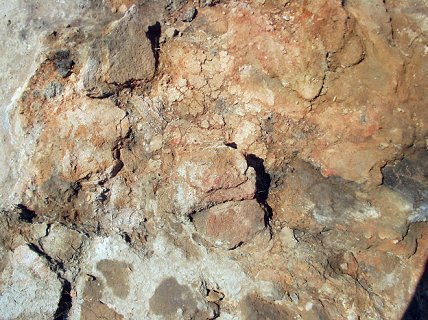 The
inferior part of the floor was not plastered with clay. When the
upper level burned the first to burn were the structures that sustained
it; so while the fire burns the upper level starts to fall down
slowly. Finally it falls down from less then 1 m. We can assume
this because in case of a fall from a superior height, the fragments
were spread over a large area. When the floor has several clay soldering,
the area is not burned, just baked, because of the worming of the
adobe. Sometimes even the upper part burned, especially in the edges
area, under the lateral walls. The
inferior part of the floor was not plastered with clay. When the
upper level burned the first to burn were the structures that sustained
it; so while the fire burns the upper level starts to fall down
slowly. Finally it falls down from less then 1 m. We can assume
this because in case of a fall from a superior height, the fragments
were spread over a large area. When the floor has several clay soldering,
the area is not burned, just baked, because of the worming of the
adobe. Sometimes even the upper part burned, especially in the edges
area, under the lateral walls. Fig. 33. Casa Cerbului, room D. Floor plastered with 5 clay strata; the upper ones, unburned The northern wall The northern wall from room B is the best-preserved one and has the strongest wooden structure. On the western wall the wooden structure was horizontally arranged. In such areas the wall was relatively less destroyed, compared with the upright structure, that was much more damaged. In the inner structure of the wall we can see traces of wooden rods and pillars, arranged at 2-6 cm distance. Fragments belonging to one or two big pots have been discovered (they have been secondary burned). Big pots are dispersed over the area; some of them contain bones.
|
|||||||||||||||||||||
